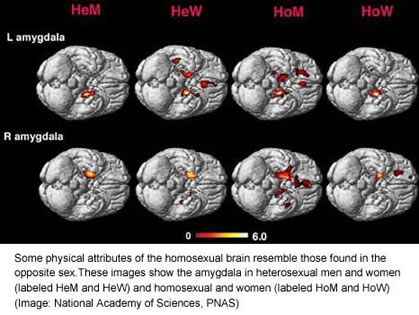 Continuing the “sex” theme of this mornings posts a Swedish study, published in the Proceedings of the National Academy of Sciences journal, suggests that the brains of gay men and women look like those found in heterosexual people of the opposite sex.
Continuing the “sex” theme of this mornings posts a Swedish study, published in the Proceedings of the National Academy of Sciences journal, suggests that the brains of gay men and women look like those found in heterosexual people of the opposite sex.
Brain scans have provided the most compelling evidence yet that being gay or straight is a biologically fixed trait.
The scans reveal that in gay people, key structures of the brain governing emotion, mood, anxiety and aggressiveness resemble those in straight people of the opposite sex.
The differences are likely to have been forged in the womb or in early infancy, says Ivanka Savic, who conducted the study at the Karolinska Institute in Stockholm, Sweden.
Link to read more ( New Scientist, June 16, 2008) Gay brains structured like those of the opposite sex
Source: New Scientist
A unique new study from the Swedish medical university Karolinska Institute (KI) suggests that the attitude of families and the public have little impact on if adults decide to have sex with persons of the same or the opposite sex. Instead, hereditary factors and the individual’s unique experiences have the strongest influence on our choice of sexual partners.
The study is the largest in the world so far and was performed in collaboration with the Queen Mary University of London. More than 7,600 Swedish twins (men and women) aged 20-47 years responded to a 2005 – 2006 survey of health, behaviour, and sexuality. Seven percent of the twins had ever had a same-sex sexual partner.
“The results show, that familial and public attitudes might be less important for our sexual behaviour than previously suggested”, says Associate Professor Niklas LÃ¥ngström, one of the involved researchers. “Instead, genetic factors and the individual’s unique biological and social environments play the biggest role. Studies like this are needed to improve our basic understanding of sexuality and to inform the public debate.” [continue reading…]
 Watch this facinating series these time-lapse animations, compiled from brain scans taken over many years, neurologist Paul Thompson of the University of California, Los Angeles, describes brain maturation in children with and without schizophrenia. Move the slider beneath the image to see the changes over time.
Watch this facinating series these time-lapse animations, compiled from brain scans taken over many years, neurologist Paul Thompson of the University of California, Los Angeles, describes brain maturation in children with and without schizophrenia. Move the slider beneath the image to see the changes over time.
Read Benedict Carey’s article From the Elusiveness of Schizophrenia, New Clues to Treatment Published June 13, 2008 in the New York Times
The people who suffer from schizophrenia are hardly the only ones confounded by its symptoms. Scientists are baffled, too, and despite years of study they’ve had little success in explaining how the disorder develops, in whom, and why.
Yet there’s a restless energy among psychiatric researchers now, and it’s in part because of several recent studies that, paradoxically, reveal how insufficient current theories about schizophrenia are.
Source: New York Times
Â
 Today the BPS Research Digest documents the fascinating case of a 10 year old boy with Tourette’s syndrome and obsessive compulsive traits, who believed he was responsible for the 9/11 terror attacks because he had failed to complete one of his daily rituals.
Today the BPS Research Digest documents the fascinating case of a 10 year old boy with Tourette’s syndrome and obsessive compulsive traits, who believed he was responsible for the 9/11 terror attacks because he had failed to complete one of his daily rituals.
The boy described as “extremely pleasant and likeable” and with good school grades – was first referred for consultation a year before 9/11 took place. As is characteristic of people with Tourette’s syndrome, the boy displayed several forms of uncontrollable tics, including excessive blinking and vocal outbursts, and he also showed obsessive tendencies and attentional problems.
Â
Â
Â
 Continuing the “sex” theme of this mornings posts a Swedish study, published in the Proceedings of the National Academy of Sciences journal, suggests that the brains of gay men and women look like those found in heterosexual people of the opposite sex.
Continuing the “sex” theme of this mornings posts a Swedish study, published in the Proceedings of the National Academy of Sciences journal, suggests that the brains of gay men and women look like those found in heterosexual people of the opposite sex.

